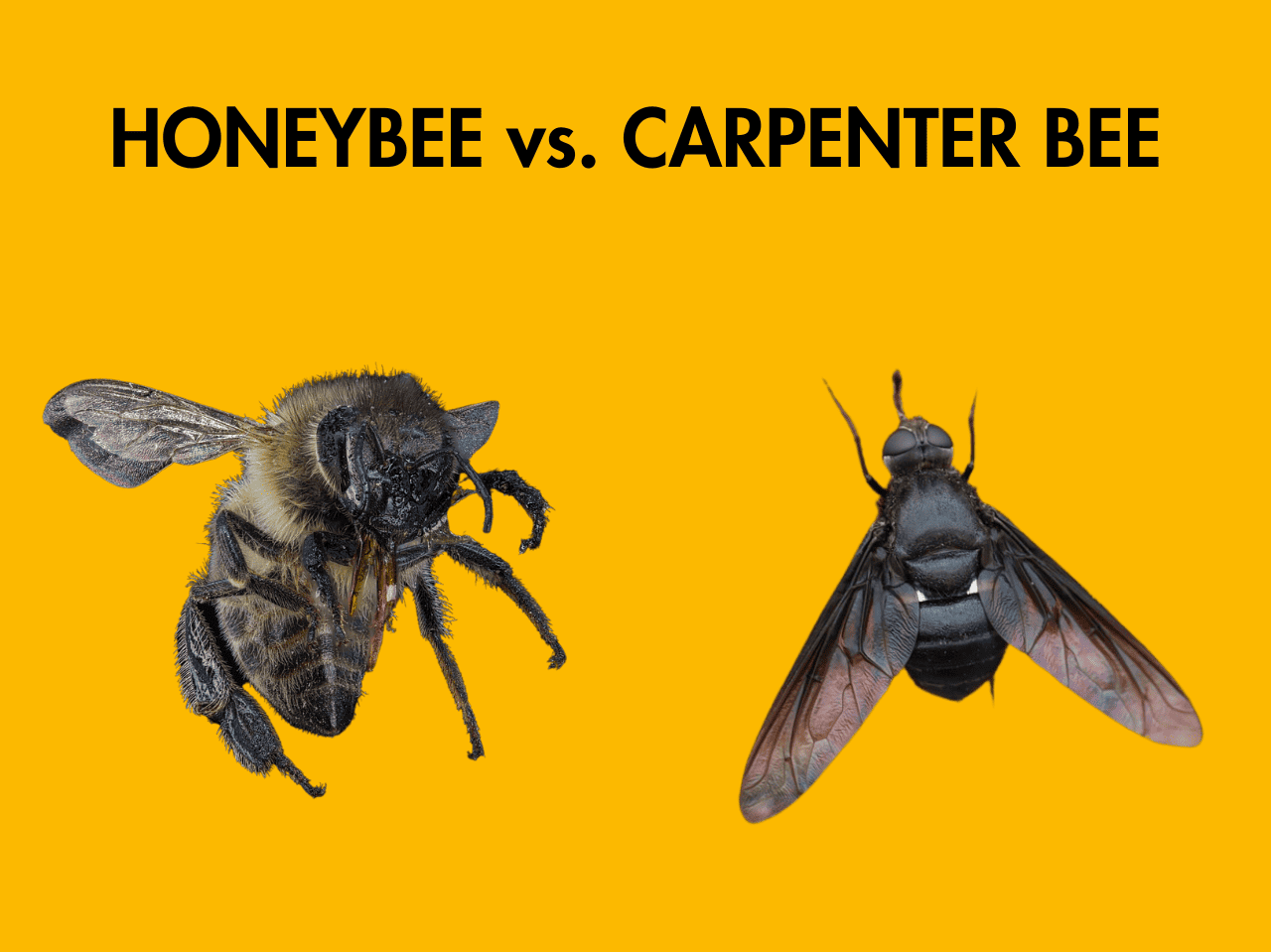When comparing honey bees to carpenter bees, it’s essential to understand the distinct differences and similarities between these two fascinating bee species. Both play crucial roles in our ecosystem but exhibit unique behaviors and physical traits that set them apart. Both species have specifically different roles in the ecosystem.
Beyond their size and abdomen appearance, we will explore even more physical differences between honey bees and carpenter bees. We’ll also explore their nesting habits – from tunnel creation by carpenter bees to external hive building by honeybees.
Furthermore, we will discuss aggression levels towards humans for both species, comparing female defensive stinging behavior with wasps’ and hornets’ aggression levels. In addition to this aspect of human interaction, we’ll examine the social structure within colonies: eusocial organization in honeybee colonies versus solitary dwelling of carpenter bees.
Lastly, understanding each species’ role is vital when considering honey bees vs. carpenter bees in terms of ecological impact and benefits provided to humans through pollination roles or even the production of delicious honey. Finally, let us not forget about their stinging capabilities – highlighting key differences like female-only stingers or one-time use for a particular bee type compared to reusable ones found on another!
Physical Appearance Differences
One of the most noticeable differences between carpenter bees and honey bees is their appearance. Carpenter bees have hairless black shiny abdomens, while honeybees possess fuzzy abdomens with a hairy thorax and head. Carpenter bees tend to be bigger than honeybees, with some reaching up to 1.5 inches in length.
Yellow Coloring on Thoraxes
Honeybees typically have yellow bands or stripes on their thoraxes, which makes them easily distinguishable from the solid black coloration of carpenter bees. This characteristic feature helps hobby beekeepers identify these two bee species.
Size Comparison Between Species
- Carpenter Bees: Length ranges from 0.3 to 1.5 inches depending on the specific type.
- Honey Bees: Average length is around 0.4 to 0.6 inches.
- Bumble Bees: Similar in size to carpenter bees but with a fuzzier appearance.
In conclusion, understanding these physical distinctions will help you differentiate between honeybees and carpenter bees when observing them in your garden or during beekeeping activities. Both bee species are excellent pollinators, but honeybees live in colonies with a social hierarchy, while carpenter bees are solitary insects.
It’s also important to note that only female worker bees in honeybee colonies can produce honey, while both male and female carpenter bees do not produce honey.
Physical appearance differences between honey bees and carpenter bees are distinct, as the yellow coloring on thoraxes and the size of each species can easily be distinguished. It is essential to comprehend the nesting practices of both types of bees for a deeper insight into how they relate to their surroundings.
Nesting Habits
Another key difference between carpenters and honey bees is their nesting habits. As their name suggests, carpenter bees bore into trees or man-made wood structures to create tunnels for laying eggs, whereas honeybees build external hives similar to other bee species like bumble bees. Consequently, carpenter bee nests can cause structural damage over time due to extensive tunneling networks.
Structural Damage Caused by Carpenter Bee Nests
Carpenter bee infestations may lead to significant damage if left untreated. Continually excavating tunnels weakens the integrity of wooden structures such as decks, fences, and house frames.
To prevent further harm from these solitary insects, homeowners must identify and address carpenter bee activity early on. Learn more about identifying signs of a carpenter bee infestation at this helpful guide by University of Kentucky Entomology Department.
External Hive Construction by Honeybees
In contrast with the destructive tendencies of carpenter bees, honeybees construct intricate external hives using wax produced by female worker bees. These complex homes serve as both living quarters and storage facilities for honey production – a valuable resource that humans have been harvesting throughout history.
For tips on maintaining healthy honeybee colonies in your backyard apiary or garden area, visit this informative article on the Hobby Farms website.
The external hive construction of honeybees is an example of the intricate nesting habits they possess, while carpenter bees create nests that can cause structural damage. The social structure variations between these two species are just as distinct and will be discussed in further detail next.
Social Structure Variations
There is a fundamental distinction in social structure between honey bees and carpenter bees. Unlike the traditional eusocial organization observed among hive-dwelling honey bees, where the queen reigns supreme alongside worker drones attending to her every need and want, no such hierarchy exists among solitary-dwelling carpenter bees.
Eusocial Organization in Honeybee Colonies
Honey bees are social insects, living together in large colonies consisting of a single queen bee, female worker bees responsible for various tasks like foraging and caring for larvae, and male drones whose primary role is mating with the queen. Honey bees are excellent pollinators and produce honey, which is crucial to our ecosystem.
Solitary Lifestyle of Carpenter Bees
In contrast, carpenter bees lead more independent lives as solitary insects. They choose to live peacefully side-by-side without engaging in violent confrontations with one another despite their proximity. Sometimes they even share the same tree trunk space. Carpenter bees are a type of native bee and are also excellent pollinators.
Honeybee colonies possess a complex social arrangement that allows for effectively allocating duties. On the other hand, carpenter bees live a solitary lifestyle with unique advantages. After examining their contributions, honeybees and carpenter bees are critical for pollination and honey production.
Roles in the Ecosystem
Both honey bees and carpenter bees are eco-friendly insects that serve as essential pollinators. However, a significant difference between these two species is that only honey bees produce valuable resources like wax and nectar-rich substances (honey), which humans regularly consume across various cultures worldwide throughout history till date.
On the other hand, carpenter bees do not contribute commercially viable products beyond helping plants reproduce via pollination.
Honey Production by Honeybees
Honey production, an exclusive trait of honeybees, has been a crucial resource for humans since ancient times. Not only does it serve as a natural sweetener, but it also offers numerous health benefits due to its antioxidant properties.
Importance of Both Species as Pollinators
The role of both bee species as excellent pollinators cannot be overstated. They play a vital part in maintaining biodiversity within ecosystems by transferring pollen from one flower to another, thus facilitating plant reproduction.
In fact, according to the US Forest Service, native bees such as carpenters and bumblebees are often more efficient at pollinating specific crops than their honeybee counterparts.
Honeybees and carpenter bees impact the natural environment, supplying us with honey from one species. On the other hand, carpenter bees are essential pollinators that contribute to plant reproduction. Now let’s look at the stinging capabilities and aggression levels between males and females of each species.
Stinging Capabilities and Aggression
Regarding stinging capabilities, there are critical differences between female honey bees and carpenter bees. Only females of both species can sting humans, but their stingers vary in structure.
Female Bee Stinging Abilities
Female honey bees can only sting once, as their barbed stinger becomes lodged in the victim’s skin, leading to their death shortly after. On the other hand, female carpenter bees possess smooth stingers, allowing them multiple uses without fatal consequences following the initial attack.
Harmless Nature of Male Bees
Males of both species cannot sting, rendering encounters with people or other animals harmless. Male honey bees, or drones, do not possess a functional stinger. This means that hobby beekeepers need not worry about aggressive behavior from male members of either carpenter bees or honey bees.
Female bees are capable of stinging and can be pretty aggressive. However, male bees are harmless. Preventing damage to property from bee populations is an integral part of managing them successfully; this requires understanding the different treatment frequencies for carpenter bees and maintenance procedures for honeybees.
Preventing Damage and Managing Populations
Managing populations of carpenter bees requires treatment three times per year (spring, mid-summer, and early fall) to prevent excessive wood damage caused by their nesting habits. On the other hand, honey bees can be maintained with standard procedures to keep healthy numbers in the surrounding environment.
- Treatment frequency for carpenter bees: To effectively deter future infestations and manage potential problems arising from unchecked growth within local communities worldwide, it is recommended to patch holes created by these solitary insects and paint over affected areas.
- Maintenance procedures for honey bees: Ensuring proper hive placement and regular inspections are essential to maintaining a thriving colony of these social insects. Providing them with ample food sources, such as flowering plants, can help support their role as excellent pollinators.
Taking preventive steps like the ones discussed can help not only safeguard your property but also aid in safeguarding the extensive biodiversity essential for our planet’s existence. With over 25 thousand recorded bee species globally, we must do our part in ensuring their long-term sustainability.
Male carpenter bees are often mistaken for bumble bees, while female carpenter bees are often confused with honey bees. However, carpenter bees do not live in hives or produce honey, unlike honey bees. Additionally, male bees of both species do not have stingers, while female worker bees do.
It’s important to note that honey bees are not the only species of bees that produce honey. Native bees, such as stingless bees, also produce honey. However, honey bees are the most commonly recognized species for their honey production and are widely used in commercial beekeeping operations.
FAQs about Honey Bees vs. Carpenter Bees
What is the difference between carpenter bees and honey bees?
Carpenter bees are larger, have a hairless black abdomen, and live solitarily. They create tunnels in wood for nesting. Honey bees are smaller, with a fuzzy abdomen, and live in eusocial colonies within external hives. Honey bees produce honey, while carpenter bees do not.
Can carpenter bees produce honey?
No, carpenter bees do not produce honey. Only honeybees make honey as they collect nectar from flowers to store it in their hive for food during winter.
What is the difference between a queen bee and a carpenter bee?
A queen bee is a reproductive female in a honeybee colony responsible for laying eggs and maintaining population growth. Carpenter bee refers to an entire species of solitary-dwelling wood-boring insects that do not have queens or organized colonies like those found among honeybees.
Are carpenter bees friendly?
Carpenter bees are generally non-aggressive towards humans unless provoked or threatened near their nests. Female carpenters can sting but rarely do so; males cannot sting but may exhibit territorial behavior around nesting sites without causing harm.
Conclusion
In conclusion, honey bees and carpenter bees differ in physical appearance, nesting habits, aggression levels towards humans, social structure within colonies, roles in the ecosystem, honey production, and stinging capabilities.
Honeybees have fuzzy abdomens and build external hives, while carpenter bees have a hairless black abdomen and tunnel into wood to create nests. Female honey bees are more defensive than carpenter bees, but both play essential roles in pollination. Bumble bees are another bee species that are excellent pollinators.

